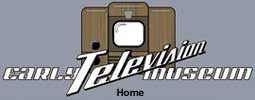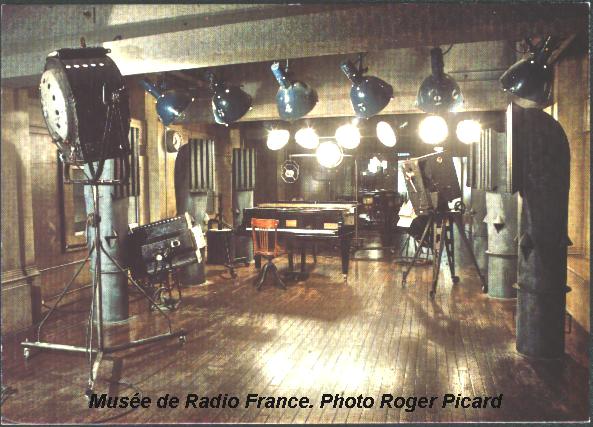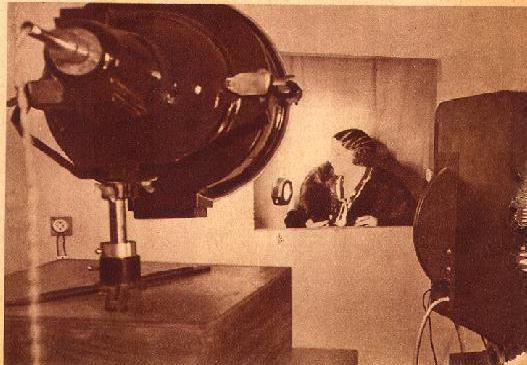

 |
 |
Part Two

Reconstitution of the french P.T.T. studio, Rue de Grenelle - Paris (1935).
One distinguishes the mechanical camera (on the right) and the air intakes for cooling.
(Copyright Museum of Radio France. Photograph Roger PICARD).
At the C.D.C., Rene BARTHELEMY used two techniques for catch of sight during his 30 lines experiments. The first, baptized 'flying spot' by the English, was used between 1928 and 1932. It consisted in sweeping the subject plunged in a total darkness, with a thin spot of intense light. The light reflected by the subject was transmitted to the photocells located in front of it.
The spot of light was obtained through an arc lamp which light was directed either, onto a mirror drum or onto a Nipkow disc, according to the type of camera used. The light passing successively through each holes of the disc, or reflected by each mirror of the drum, lit the face of the subject.
Regarding the low sensitivity of the photocells of that time, the flying spot analyzing technic came to be the most efficient method. It presented however an enormous disadvantage as it was almost impossible to scan subjects other than human faces or tops with a reduced framework!
The second technique was more practical. It used a Nipkow disc camera and was called 'catch of sight in diffuse light'. This time, the subject or the scene was entirely (and violently) enlightened and the single photocell placed behind the disc received the reflected light passing through the holes of the disc.

Consequently, to avoid endangering the actors health, the studio jas to be equipped with an efficient cooling system! It should be noted that in spite of that, the room temperature of the studio frequently reached the 35° centigrades during the first experiments!
With the development of the first photomultipliers tubes in 1936, one could replace the photocells by those and consequenly, increase considerably the sensitivity of the mechanical camera. Indeed, the photomultiplier helped a lot the 180 lines television , which required at its beginnings a phenomenal amount of light in the studio (48.000 Watts!)
Because of the low sensitivity of the first television cameras, it was also necessary to study a special make-up in order to highlight the features of the actors. That is: black contour of the eyes, white and light orange cheeks, black or dark purple lips etc.. The pretty same way as it was during the beginnings of the cinema.
During the very first experiments in television, the camera and the subject where not able to move. This was particularly true when using the flying spot technique.
Later on, during the first official TV transmission of the french PTT in April 1935, both 60 lines and 180 lines mechanical camera were placed side by side behind a glass panel. That was to avoid the noise of the motors to come out and be transmitted. The early television program were composed by one, then by two to three people people moving in the narrow field of the camera. Also the telecinema helped a lot, adding more interest for the 'televiewer'.
Early 30 lines television environment.
The main characteristic of the first televised images was their very low definition: 24 to 60 lines, compared to the actual 625 lines . Despite the lack of details which affected them (this was not only related to the low definition, but also with the low performance of the radio video amplifiers) people enjoyed much seeing this small redish and unstable image.
To see and hear a television program by that time (1930), one needed two radios receivers in addition to the television machine. This last consisted mainly of a frame on which the scanning disc and its driving motor were installed with various adjustments for framing the image and adjusting the speed of the disc. Behind the disc, was the neon lamp and its assembly.
Some mechanical television sets included improvements like the model of the German manufacturer TEKADE, around 1932. On this device, one could choose either to watch the BAIRD images, swept in the vertical direction, or the French BARTHELEMY images, swept in the horizontal direction. The change of standard was done by turning a knob which rotated the neon lamp assembly on one or other of the two spirals of the disc. There was thus, two windows of vision and one watched through one or the other.
In a common early television home installation, two radios receivers were used to collect respectively the sound and the image signals part of the television program.
Out of the television broadcast schedule, either of those radio sets could have been used for listening at ordinary music broadcasting.
When the voice of the radio speaker was replaced by a noise pretty like the one of a bumblebee, it meant that time came for receiving television program. This sound corresponded to the 30 lignes audible image signal.
It was time to connect the neon lamp in place of one of the radio receivers loudspeaker. The other duties that remained, were doing image framing and the scanning disc's speed adjustment.
After some unsuccessfull attempts, most skilful people managed to domesticate the machine and could finally see the reddish, trembling and fuzzy 30 lines images stabilize itself.
Apart actors faces or top chest, what could the first televiewers see on their machine? As soon as 1930, the C.D.C television laboratory, developped a telecinema machine to broadcast movies on 30 lines television. Thanks to the image format of 4/3, it was thus, possible for people to watch films on their mechanical television sets.
The telecinema was a machine of imposing size, equipped with a special exploring disc provided with holes on a circumference and placed in front of the film which ran uninterrupted in front of a narrow slit.
About the covering of the experimental television broadcasting, it should be noticed that thanks to the wavelengths used by that time, it was often possible to receive the BBC programs in northern France and in Paris.
Also, the experimental broadcast from the CDC, could be received as far as the southern France, when the propagation was good enough.